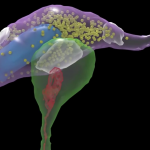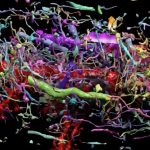By Amanda Koehn
A comprehensive map of the human brain is in the works with the promise of eventually creating new neurological treatments and diagnoses for mental illnesses, Alzheimer’s disease and other disorders.
The BRAIN Initiative researchers at the University of Chicago, Argonne National Laboratory and in labs around the country are in the beginning stages of mapping, starting with mice and moving up the scale to humans.
Creating this human brain map would require the equivalent of half the digital storage of all the hard drive space on earth. The feat has been compared in scale to the Human Genome Project and the moon race, although with a less defined endpoint in mind.
The National Institutes of Health recently announced $85 million in funding for the BRAIN Initiative for 2015. So far it has over $300 million in funding, from the NIH, the Food and Drug Administration and other public and private groups combined.
A recent program, “What is the BRAIN Initiative?” gave researchers the opportunity to explain the initiative and answer questions at the Hughes Auditorium on Northwestern University’s Lakeshore campus.
The event, hosted by the Chicago Council on Science and Technology, Argonne and the Chicago Society of Neuroscience, featured three area researchers to explain their latest work bringing us closer to understanding the human brain.
The BRAIN Initiative, or the Brain Research through Advancing Innovative Neurotechnologies, is a federal program started in 2014 to better understand the brain to treat neurological and psychological disorders.
While scientists today generally know what areas of the brain control the dexterity to flip a pancake or to calculate differential equations or experience anxiety, the neural level is a new frontier. Neurons, considered the building blocks of the brain, are cells that transmit information through the brain and spinal cord. Neurons form an elaborate web of networks that are thought to be entirely connected to one another, forming what is called a connectome. This connectome– the neural maze of the brain– is what researchers are trying to map
Dr. Bobby Kasthuri, one of the event speakers, is an MD and neuroscience researcher at Argonne National Laboratory and an assistant professor in neurobiology at the University of Chicago. He explained how his research using electron microscopes to study slivers of mouse brains could lead to a more complete picture of what brain networks look like at the connectome level.
“We still imagine neurons in these beautiful paths and connecting to very specific cells, and what’s incredible about this is it’s probably wrong,” Kasthuri said.
Kasthuri described how slicing mouse brain cells is akin to “cutting spaghetti,” however the result a bit more complex. The samples under a microscope show neurons, which can be traced to connect to one another– the beginnings of a connectome, albeit in mice.
Kasthuri showed the diagram describing the lack of computer storage when you need enough space to map a human brain. He is also an innovator in terms of how he explores the brain images. He crowdsources high school students to trace images of mouse brains, connecting neurons to map his images. At his previous position at Boston University, he recruited some 100 students (who still work with him via Skype) and wants to extend it in Chicago.
“It works great because they are essentially free, but I teach them neuroscience. And somewhere they get the idea that they become committed to the actual research,” Kasthuri said.
John Maunsell, a neurobiology professor at the University of Chicago, said it is a prime time for the BRAIN Initiative. Technological and scientific advances only in the last 10 years have made mapping the brain close to possible, said Maunsell, director of the university’s Grossman Institute for Neuroscience, Quantitative Biology and Human Behavior. Using these tools, scientists are now developing goals of the BRAIN Initiative, which involve creating brain part lists, building wiring diagrams and developing links between brain function and behavior.
“One of the things we are trying to understand now is what makes up attention,” Maunsell said. “It’s actually not just one thing, but instead it’s made up of many distinct neurological mechanisms.”
Tom Macek, scientific director of clinical sciences CNS at Takeda Development Center Americas, explained that the urgency of the BRAIN Initiative for him and many others, is that we desperately need improved treatments for mental illness.
“Hundreds of millions of people worldwide are affected by mental illness,” Macek said. “It affects their thinking, their mood and their ability to relate to others.”
Working in the pharmaceutical industry (his work is does not receive funding from the BRAIN Initiative), Macek cited the high cost for pharmaceutical companies in developing psychiatric drugs. Because we know so little about the brain, failure to produce adequate drugs is common–making testing very costly.
“What this has led to in my industry is that a number of companies are leaving,” Macek said.
He also acknowledged that the BRAIN Initiative in itself could be useful for making science more transparent amongst research peers, since they share a common goal. “It promotes the sharing of information and knowledge in what we would consider a pretty competitive space,” Macek said.







